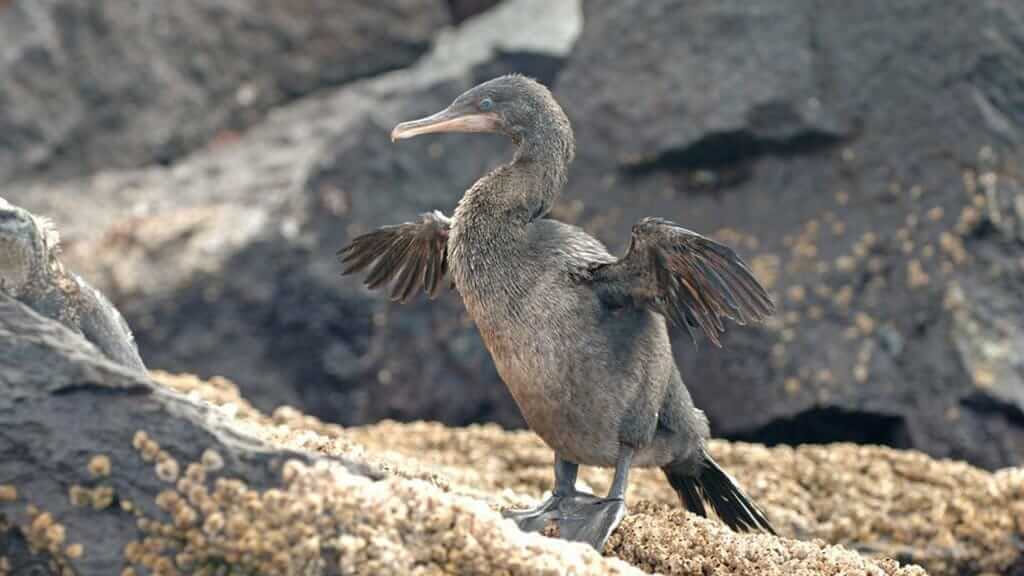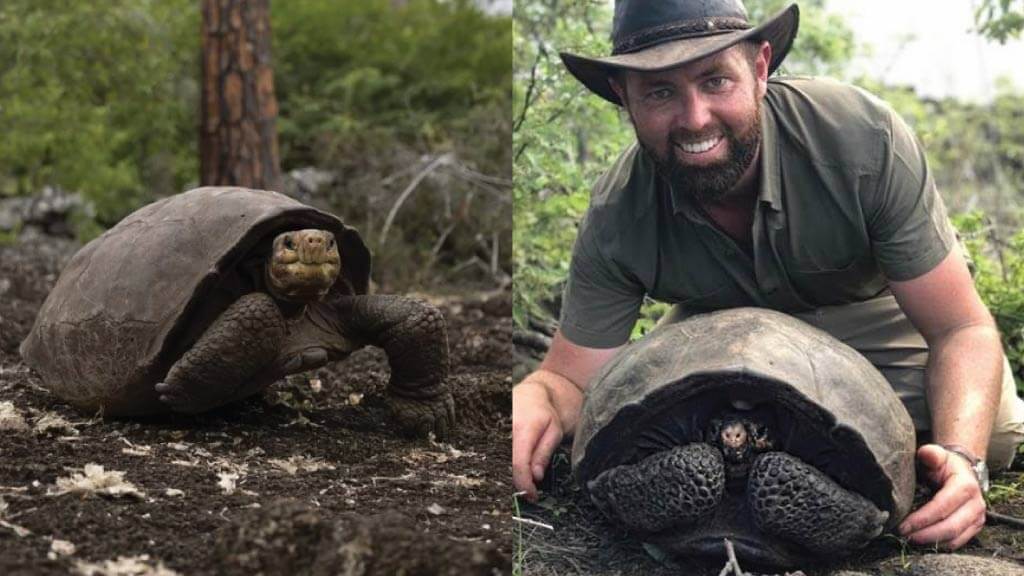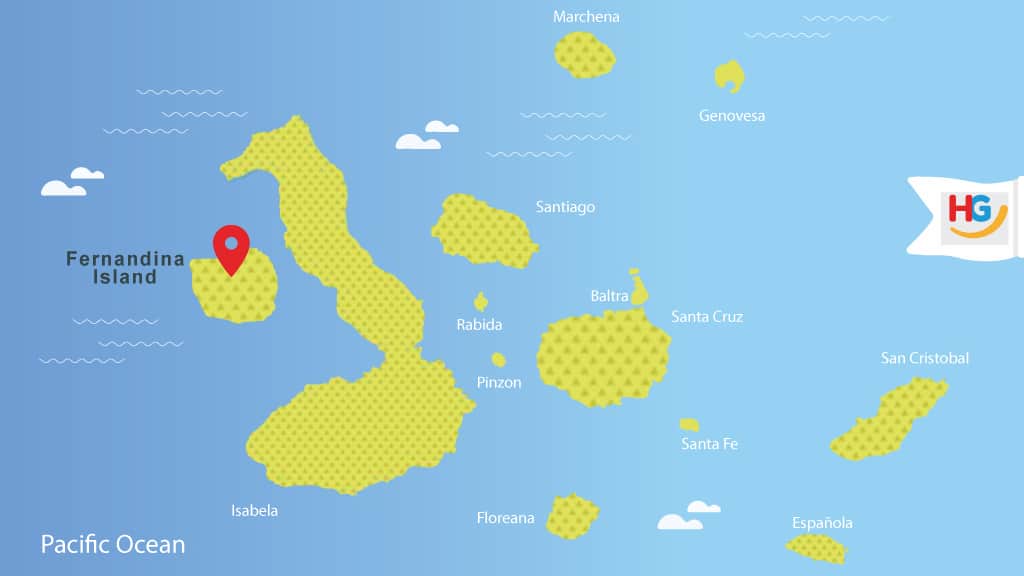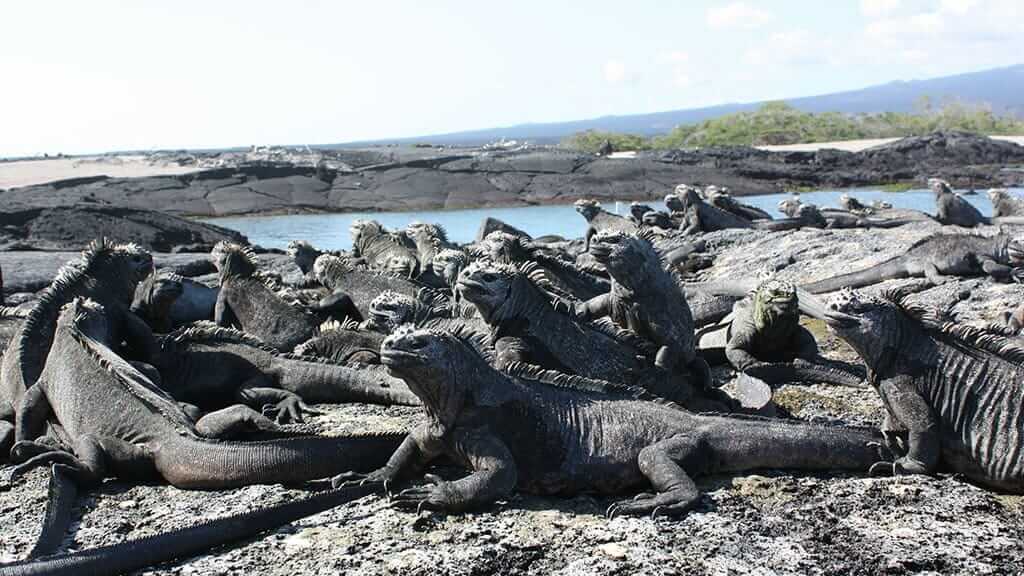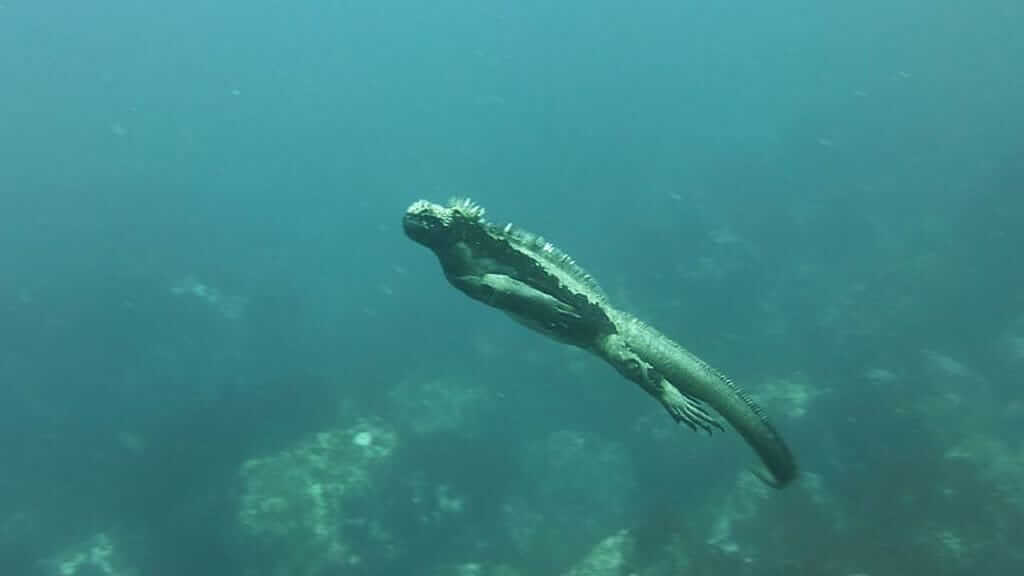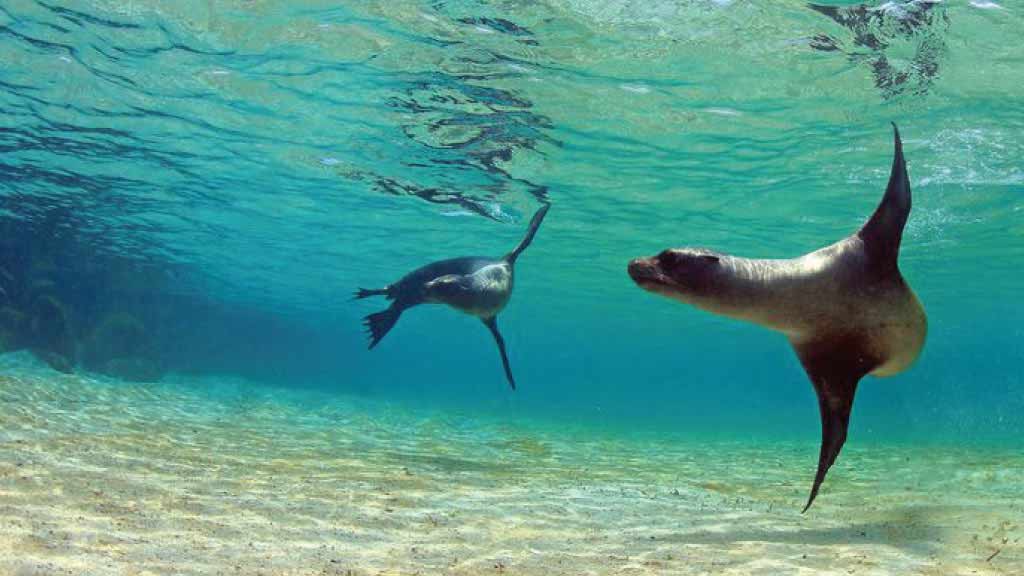Fernandina Island Galapagos (Isla Fernandina)
Fernandina Island is right up at the top of the list of best sites to visit on the Galapagos Islands. Fernandina was born of fire, and today is one of the most volcanically active spots on the planet. Evidence of black lava flows is everywhere, and lucky visitors might even witness a live eruption themselves. But Fernandina Island is not just about landscapes, the wildlife is very special too. This is one of the only places to spot the Flightless Cormorant – the curious bird who forgot how to fly. Fernandina Island is also home to cute Galapagos penguins, and a huge colony of Marine Iguanas. In season, it's also the best place for whale watching in the archipelago. Whichever way you look at it, Fernandina Island is a pretty amazing place, even by the high standards set by other Galapagos islands.
Keep reading for everything you need to know to plan your visit to Fernandina Island. What Galapagos wildlife can visitors spot there? What are the best Fernandina activities and visitor sites? Also, learn about the interesting geology of Fernandina Galapagos.
SECURE YOUR GALAPAGOS TRAVEL
Get a FREE personalised quote todayFernandina Island Galapagos Wildlife Highlights:
• Fernandina Island is the best place in Galapagos to find the fascinating Flightless Cormorant.
• Here be dragons! Fernandina is also home to the largest and darkest-colored Marine Iguanas at Galapagos.
• The Bolivar Channel between Isabela and Fernandina islands is the top spot for Galapagos whale watching.
• Fernandina Island offers an unforgettable chance to snorkel with Galapagos penguins, as they enjoy the plentiful food in these cold waters.
• For those who watched a terrified baby marine iguana escape from racer snakes on BBC Planet Earth - all of the action was filmed right here at Fernandina Island Galapagos
• Fur Seals are a common sighting around the rocky ledges and crevasses on Fernandina. See if you can tell the difference between them and Galapagos sea lions.
• Other Fernandina Island animal highlights to look out for include Blue Footed Booby, Galapagos Sea Lion, and Sally Lightfoot crab.
About Fernandina Island
English Name: Narborough
Ecuadorian Name: Fernandina
Total Area: 248 sq miles
Fernandina Population: zero (uninhabited)
Fernandina Island is hot property. Quite literally, this is as close as you get to the Galapagos volcanic hotspot. Volcanologists constantly monitor activity here, and spectacular eruptions every few years are common. Yet many Galapagos animals have remarkably learned to adapt and live here. Fernandina land iguanas even live on the slopes of the volcano itself, using thermal heat to incubate their eggs.
The presence of a great diversity of wildlife owes much to the rich waters that surround Fernandina Island. Here a unique marine upwelling occurs. The cold Cromwell current brings with it nutrients and plankton from the west, forming important feeding grounds for Galapagos marine species. These conditions are perfect for sea birds like Galapagos Penguins and Flightless Cormorants. There’s also plentiful food for mammals (Galapagos fur Seals), and reptiles (marine iguanas). But larger visitors can also be spotted. This is the best spot in the Galapagos for whale-watching, especially from June to November.
Fernandina Island Geology
Fernandina is the closest island to the Galapagos hotspot, so it comes as no surprise that this area is volcanically active. Fernandina is the youngest island in the archipelago, created between 300,000 and one million years old. On average there is a small eruption every 5 years or so, the last ones occurring in 2005, 2009, and 2018. Today, visitors can enjoy wonderful views of the 6.5km wide caldera of La Cumbre Volcano. This is a long and flat shield volcano that takes up much of the island itself. Volcanic eruptions can occur inside the huge caldera, or on the volcano slopes. The land iguanas that live there are often able to sense increased volcano activity in advance, giving them time to descend to safety.
Fernandina Galapagos Habitat
As you might expect, Fernandina Island is rather barren without much vegetation. The surface is made up of historic lava flows and volcanic rocks, with little or no soil to help plant life. This habitat is typical of a young Galapagos volcano in the early years of life. Plant colonization is more common on the islands that have tectonically drifted further east, and had more time for soil to form. Extraordinarily, pioneer cacti have managed to gain a foothold. Fernandina Island is home to a wonderful miniature cacti forest, proving its impressive resilience. Mangroves have also been able to grow in this harsh habitat.
Fernandina Island History
Fernandina Island was first named in 1684 by British buccaneer Ambrose Cowley. He chose to name it Narborough, after Sir John Narborough, an English naval commander of that era. The island’s Spanish name, Fernandina, honors King Fernando of Spain, the sponsor of the voyage of Christopher Columbus.
Fun Fernandina Island Fact:
Fernandina is one of the most pristine islands found anywhere on the planet. No species have ever been introduced here by humans. The Galapagos animals that you see today all arrived by their own devices. Genovesa is the only other Galapagos island to boast the same claim as Fernandina. The National Park Authority monitors the island, to ensure that no new species are accidentally introduced, especially rats.
Fernandina Island Tortoise:
Incredibly, life on Fernandina Island in Galapagos is still being discovered today! Just recently in 2019, a subspecies of Galapagos Giant Tortoise thought extinct for the past 112 years was rediscovered. A lone female Fernandina tortoise was found wandering on Fernandina and has since been confirmed as a direct genetic match to the Chelonoidis Phantasticus species, and the last known individual still alive today.
Of course, she has been named Fernanda (or Fern for short). But, what happens now? Is there hope for the repopulation of the Fernandina Island tortoise?
Fern has been safely housed at the breeding center on Santa Cruz Island, while the search for a potential mate is ongoing back on Fernandina. But, the race is on, as Fern is already considered elderly, even in this remarkable species that easily can live in excess of 100 years.
The story is reminiscent of Lonesome George, the last of the Pinta Island giant tortoises, who unfortunately passed away back in 2012 without leaving any offspring.
It also shows how many surprises are still out there waiting to be discovered at the Galapagos. Another remarkable story is that of the Isabela Island Pink Iguana, discovered in 2012 having lived alone for 5.7 million years.
GET FREE ADVICE
From a Galapagos destination expert todayWhere is Fernandina Island?
How to get to Fernandina Island Galapagos?
Fernandina is the westernmost island of the archipelago and the third largest island. Due to its isolated location, the only way to visit Fernandina Island is aboard a Galapagos yacht cruise. Not all cruise itineraries cover the western islands, so be sure to check when you plan your trip.
Contact us for a FREE TOUR QUOTE, or for more information to plan your Galapagos vacation to visit Fernandina Island.
Fernandina Island Galapagos Visitor Sites
What can visitors do on Fernandina Island Galapagos? This island offers a great combination of activities including trekking, snorkeling, and diving. Keep reading for more details below.
1. Espinosa Point (Punta Espinosa)
Landing Type: Dry, occasionally slippery.
Trail length: 1.2 miles (2km). This trek takes approx 2-3 hours at a slow pace.
Terrain: Uneven volcanic terrain so visitors should take some care.
Visitors to Espinosa Point on Fernandina Island are greeted by a barren jet-black landscape of lava. Both sharp and brittle A’a lava and smooth ropy Pahoehoe flows can be observed here. Your guide will be happy to point both out to you, so you can notice the difference. Also try to spot the amazing pioneer cacti, clinging to life here on the lave despite the lack of soil.
After checking tidal pools for mollusks and fish, you’ll head to see one of Fernandina’s main highlights – the large colony of Marine Iguanas. These cold-blooded reptiles are the only iguana species that have learned how to swim. They dive to feed on algae growing on the rocks. After returning from the cold waters they then huddle together for warmth, creating great photo opportunities. They also need to expel sea salt from their bodies, done by spitting salt through their noses. The Fernandina island marine iguanas are both the largest individuals found in the Galapagos and the darkest in color.
Continuing along the trail tending to the right, you will pass by marine iguana burrows. They dig these nests in the sand during mating season, often right next to passing tourists. Along this stretch of coast, it is also common to find sea lions playing in the surf.
Our next highlight though is a rather unusual bird. The Flightless Cormorant arrived in the Galapagos through flight but has adapted to the environment in a very surprising way. Galapagos Cormorants dive deep for fish, so have developed strong hind legs for swimming. However, the lack of natural predators means that they no longer need to fly. So today you’ll see them with just small, stubby, useless wings. They have trapped themselves on Fernandina Island, unable to fly away even if they wanted to. This amazing bird can only be found on Isabela and Fernandina islands, so enjoy this unusual wildlife treat.
The trail continues to a cove often frequented by green sea turtles, and vegetated with mangrove plants. This area is also the hunting ground for Galapagos Racer Snakes, especially during marine iguana hatching season (May and June). Fernandina snakes leaped (or crawled) to instant fame in 2016 when BBC Planet Earth caught unique footage of them chasing a baby Marine Iguana. It went viral on the internet, receiving an incredible 13 million views! Check it out on YouTube before you travel.
The final treat at Punta Espinosa Fernandina is the chance to spot Galapagos Penguins. They are the only species of penguin to live in the tropics, attracted by the abundance of food found here
2. Mangle Point (Punta Manglar)
Landing Type: No Landing.
Activity: Panga (zodiac) ride and/or snorkeling.
A visit to Fernandina's Mangle Point takes tourists on a panga (zodiac) ride into a small inlet looking for wildlife, and is also a great location for snorkeling. This coastline is a popular nesting area for both Flightless Cormorants and Galapagos Penguins, giving snorkelers an opportunity to see them underwater. Snorkelers should also keep an eye out for Marine iguanas, Galapagos sea lions, Green sea turtles, rays, sharks, sea horses, and colorful reef fish.
Don’t forget to keep your eyes on the sky too. Mangle Point is a good opportunity to spot Galapagos Hawks soaring high above.
3. Cape Douglas (Cabo Douglas)
Landing Type: No Landing.
Activity: Scuba Diving.
Cape Douglas at Fernandina Island is a Galapagos dive site with moderate currents, suitable for advanced divers. Here Galapagos Fur seals share the depths with sea lions, while penguins zip around searching for food. Various shark species can also be found, as well as marine iguanas snacking on algae.
It is only possible to visit Cape Douglas aboard a specialist Galapagos Diving Cruise.
The #1 Trusted
Galapagos Travel Agency
Note: All wildlife sightings are by their very nature unpredictable.
In conclusion, Fernandina Island is one of our favorite islands in the Galapagos. The birds and animals here are unique and have interesting tales to tell. The landscape is barren and black, yet breathtakingly beautiful. Few other sites on the Galapagos demonstrate so clearly the story of evolution. Birds have evolved the ability to swim instead of fly. Land reptiles have also taken swimming lessons. The island itself is also a living illustration of creation by fire and the fight for survival. The first slow steps of plant colonization are already taking place. Life is beginning and will continue evolving in ways we can never imagine. Fernandina Island is a highly recommended inclusion to your Galapagos cruise itinerary!



